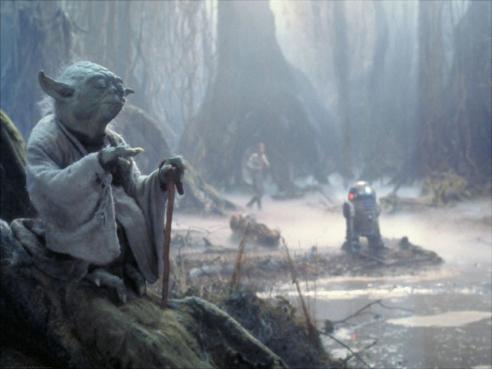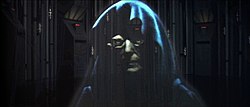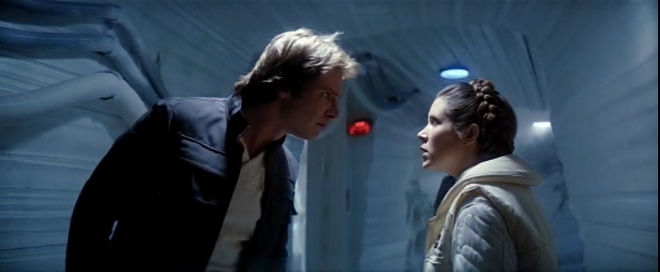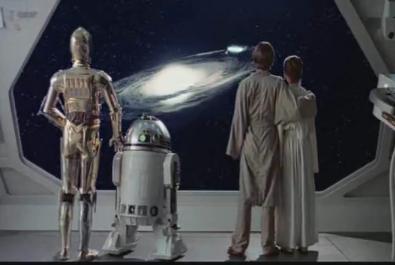 "If you end your training now - if you choose the quick and easy path as Vader did - you will become an agent of evil"
"If you end your training now - if you choose the quick and easy path as Vader did - you will become an agent of evil"Introduction
It is the sequel to the most successful film of 1977. Star Wars was inevitably going to spawn a sequel and ironically Lucas - a man who was almost as obsessed with control as Vader himself, handed the directorial duties over to Irvin Kershner. Though credited for the "story", Lucas even handed over screenplay-writing duties to Leigh Brackett (who died shortly after writing the script in 1978) and Lawrence Kasdan (Someone Lucas was impressed with through his writing on a project called Raiders of the Lost Ark). This would give the impression that Lucas became less involved - but in fact he was more involved as every penny which was put up to support the production was from his own pocket. $33 million dollars from his profit of Star Wars and what he found through loans provided the foundations for The Empire Strikes Back - who would've known that this was an independent film? Not to mention how such a huge franchise was bred from decisions that rebelled against the usual studio practices - but Lucas did it to gain complete control of the franchise. And, financially, it was worth every penny.
Three years after the Star Wars Episode IV: A New Hope (akin to the three year gap of The Clone Wars between Attack of the Clones and Revenge of the Sith), the search continues for the Rebels. Darth Vader is aware of the possible damage Luke could cause and is focussing his efforts into finding the Rebel Alliance - and crucially either killing, or turning to the Dark Side, the boy-that-has-become-a-man: Luke Skywalker. With complete control, Lucas has clearly taken the opportunity to expand the universe in a wide range of ways. There is more than one Jedi - the Master Yoda exists on Dagobah. Additionally, Darth Vader is not the only villain ... there is a Master: Darth Sidious. This is a reveal which, in the context of the saga, means little - but as the only sequel to Star Wars in 1980, this was all new.
 We meet Yoda for the first time. On the one hand, he is crazy - in the saga, he has lost his mind perhaps having been on his own for so long. But, in 1980, this was what established Yoda's iconic status. As an improvement on its predescessor, Luke is more maturer than the teenage version we meet in A New Hope, but he is rebellious ("like his Father...") as he chooses to set off and save Leia and Han Solo by ignoring Yoda and Obi Wan. But this, as the poem of Star Wars Lucas is creating, folds neatly in with the prequels as Luke - like Qui-Gon Jin and Padme - is putting his heart before his head, and falls into the "trap" of the Dark Side.
We meet Yoda for the first time. On the one hand, he is crazy - in the saga, he has lost his mind perhaps having been on his own for so long. But, in 1980, this was what established Yoda's iconic status. As an improvement on its predescessor, Luke is more maturer than the teenage version we meet in A New Hope, but he is rebellious ("like his Father...") as he chooses to set off and save Leia and Han Solo by ignoring Yoda and Obi Wan. But this, as the poem of Star Wars Lucas is creating, folds neatly in with the prequels as Luke - like Qui-Gon Jin and Padme - is putting his heart before his head, and falls into the "trap" of the Dark Side.It is difficult to fully understand the purpose of the third-person conversations - it seems Lucas is justifying the conversation Luke and Obi-Wan had in A New Hope. Originally, Obi Wan stated "a young Jedi named Darth Vader... betrayed and murdered your father", but if they want to build on the Universe and expand the stories and characters, this needs to change. Suddenly, we are told that Anakin is Darth Vader - again, a huge loss on viewers of the films in Lucas-oligical order. That apparently "Anakin" was lost when he chose to turn to the Dark Side - consumed with evil, he became Vader. This is where the entire saga falls down as all these "secrets" are no longer secrets in the saga. We know who Darth Sidious is, we know that Yoda is alive, and we already know that Anakin and Vader are one and the same. With all this known-knowledge, the use of third-person to create a narrative that suprises us when characters are revealed is redundant.
 |
| Tintin looks for a Wampa... |
But the galaxies themselves remain intact and ensure that the established worlds all represent different meanings. The release of The Adventures of Tintin: The Secret of the Unicorn in Europe coincides nicely with this analysis as I believe the story Tintin in Tibet, may have influenced The Empire Strikes Back. The documentary Tintin et Moi explains how the story Tintin in Tibet represented a point in Hergé's life when he was in rehabilitation - the vast white landscapes representing his dreams as he "dreamt in white" and he was wandering in an abyss of emptiness. When we contrast these ideas with the battle of Hoth and the world Luke is within, we understand that Luke has not even begun his training on Dagobah and knows little about the power of the force except what Obi-Wan has told him. You realise that Luke himself is a blank-sheet of paper at the start of The Empire Strikes Back, he is empty and needs 'filling up' with knowledge and wisdom from Yoda, and Obi Wan, on Dagobah.
Noting the meaning of the planet Hoth, consider Daogbah itself : overgrown and naturally left to flourish in whatever way nature intends. Luke is on the most organic planet we have seen - the X-wing crashed-down in the swamp even appears out-of-place and clearly disrupts the world. Yoda is building on the blank-sheet status of Luke and getting to the foundations of a Jedi - the "roots" of the force and what it really means. But even within this context, his heart rules out and he leaves Obi Wan and Yoda to save his friends.
As I previously noted, Luke's decision to leave Yoda and [the ghost of] Obi Wan, like the prequels, leads Luke straight into the trap of the Dark Side. It seems that the constant parrallels between films and characters continue explicitly between the saga. In fact, Kevin Mcleod agrees with the 'mirroring' concepts and ideas between the films. From the hand Luke loses in The Empire Strikes Back - the middle film in the original trilogy - to the hand Anakin loses in Attack of the Clones - the middle film of the prequels. Lucas expertly reverses the sides from one trilogy to the next - the Sith in power in the original trilogy opposed to the Jedi/Republic in power in the prequels, but both are corrupted from the inside as Anakin in both trilogies marks the end of their power.
 |
| The original Darth Sidious |
I vividly recall friends telling me how The Matrix Reloaded ended "just like Empire" - as both films ended in an exceptionally negative way, providing the lowest possible point for the characteres to claw themselves out of in the final film. Empire Strikes Back reveals crucial information but also ensures Luke loses his hand, Han Solo is frozen in carbonite and the Rebels have only just escaped Darth Vader. They are back to square one - despite Yoda and Obi Wans advice - Luke has ensured that the Rebel's are in a tricky spot now. In one sense, this is a very pessimistic and negative ending, but I believe John Williams score, which keeps the entire finale upbeat and positive, refocuses our attention.
Over six films we have come to realise that characters - and especially, good characters - learn from their mistakes. We see, vividly, Luke ignore the Jedi and this is the consequence ... but with failure comes hope. Luke will now fully trust the Jedi, knowing clearly what his goal is. Ironically, there is true importance to failure and I believe this is the optimistic ending of The Empire Strikes Back. Luke is now fully aware of what he must do - he knows that he must fully train as a Jedi and, once he has mastered this skill, his knowledge and, crucially, his telekinetic powers, that connect him with Vader will bring the Sith down.
In terms of influences, I find it hard to place clear connections to this film without repeating myself - I guess the Cloud City that features in Flash Gordon is recreated here whilst Lando Carlissian is no doubt a brilliant character plucked straight from the blaxploitation genre that was popular in the seventies (Oh, that's a genre-box Lucas didn't tick in the first film). Billy Dee Williams track record in Motown Productions, inevitably ensured that another 'target market' was now attracted to Star Wars. There is a tease as to whether Luke will turn to the Dark Side as his frustration remains that Obi-Wan lied to him about his Father but we will only find out if this is the future in Star Wars Episode VI: Return of the Jedi... [Cue Star Wars credits music]




No comments:
Post a Comment
Copyright 2008-2015. All posts & reviews are property of www.simoncolumb.wordpress.com/Simon Columb and should not be reproduced in whole, or in part, without express permission from the author.